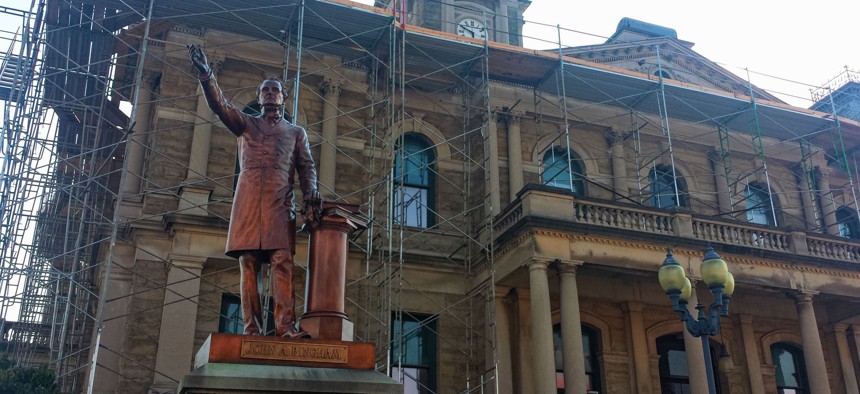Recession’s Shadow Still Hangs Over Finances of Some Counties

The Harrison County Courthouse in Cadiz, Ohio Michael Grass / RouteFifty.com

Connecting state and local government leaders
“General revenue is slowly coming back, on the other hand we’re seeing rapid increases in mandated costs,” says the author of a new National Association of Counties report.
Local government revenues for hundreds of counties around the U.S. have been slow to recover to pre-recession levels, according to a report published Tuesday.
National Association of Counties researchers looked at revenue and spending trends in 2,112 counties in 45 states and the District of Columbia. They found that by 2013 general revenues had not recovered to 2007 levels in about 46 percent of those counties, after adjusting for inflation.
The analysis also shows counties shouldering heavier cost burdens than they have in the past—highlighting questions about how the expense of basic public services should be divided between local, state and federal levels of government.
For instance, the researchers found counties faced rising costs tied to areas such as public safety, health and human services and transportation. In 48 percent of the counties overall expenses, after factoring in inflation, were higher in 2013 than they were in 2007.
And, comparing those same two years, 59 percent of the counties reported “dedicated grants” from the state and federal level were covering a smaller share of their expenses. Counties use these grants to pay for services mandated by states or the federal government.

“This report provides a good baseline of the picture on the ground,” said Emilia Istrate, NACo’s director of research and outreach. “On the one hand the general revenue is slowly coming back, on the other hand we’re seeing rapid increases in mandated costs.”
“The thing that would bridge that would be state and federal financial support,” added Istrate, who co-authored the report with NACo research assistant Daniel Handy.
County general revenues mostly come from taxes, fees, fines and grants not restricted for any particular activity. But for counties included in the NACo analysis, the bulk of the revenues, about 72 percent, came from property tax collections in 2013, according to the report.
Depending on the frequency of property value assessments, the report points out that those collections can lag behind price movements in the real estate market.
Istrate noted that 41 states have at least one limitation on the property tax increases county governments can impose. Even allowable hikes in property tax rates can be politically thorny, and frequently stir opposition among home and business owners.
As a benchmark, 2007 is significant because the Great Recession began to unfold in December that year. The report authors explained that 2013 is the latest year audited financial statements were available for the majority of counties.
The analysis mirrors other recent research, which suggests state-level revenues and spending have recovered sluggishly and unevenly since the Great Recession. It also comes at time when national economic growth is looking stubbornly lackluster in contrast to past decades.
A full copy of the NACo report can be found here.
Bill Lucia is a Reporter for Government Executive’s Route Fifty and is based in Washington, D.C.

NEXT STORY: The Recovery Begins in South Carolina. Again.





